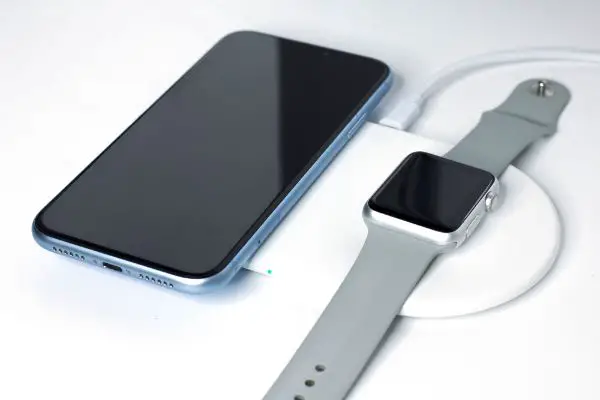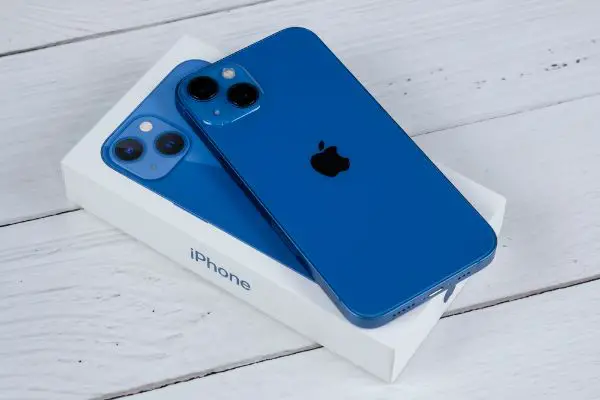Disclaimer: This post may contain affiliate links, meaning we get a small commission if you make a purchase through our links, at no cost to you. For more information, please visit our Disclaimer Page.
The iPhone battery has lithium ions in sodium solution reacting with metal electrodes. When the battery charges, these ions migrate from side to side, generating heat. A little heat is fine, but the iPhone should never become too hot to touch.

(Attribution: ©[Dorieugene]/Depositphotos.com)
Table of Contents
iPhone CPU
The iPhone has a CPU that operates its OS, applications, and even fundamental functions like receiving calls. Each calculation performed by the iPhone consumes energy, and some of this energy is squandered as heat. So, if you use your iPhone a lot while it’s charging, you risk overheating it and pushing it dangerously close to a critical temperature.
Using iPhone While Charging
The term “Apps” refers to any application that comes pre-installed on the iPhone or downloaded from the Apple Store. So while the iPhone is charging, you can utilize apps.
However, if you run too many of them simultaneously, you will raise the device’s thermal levels. Consequently, if you drive the iPhone’s thermal load too high, you may limit the battery’s life and even damage its delicate internal components.
Maximum Temperature Envelope
The phone was designed to generate and dissipate a specified quantity of heat. If the iPhone becomes too hot, you may receive an error message stating that the “iPhone must cool down before use.” This error message shows when the iPhone’s temperature has reached a crucial level.
This can be avoided by using your iPhone for only the most essential features while charging. For example, you may like to confine yourself to a single app for making and receiving calls.
How to Determine When an iPhone Is Completely Charged
Apple’s iPhone is a multimedia and cell phone gadget. Your iPhone will require recharging regularly, and charging it may take up to an hour, depending on the current charge level.
Below are steps to follow to ensure your iPhone is fully charged:
- Step 1: Connect your iPhone to the charger that came with it to an electrical outlet.
- Step 2: Allow the phone to charge on its own. Charging will take longer if you use some of the battery’s charge to operate the machine.
- Step 3: Check the battery symbol in the iPhone’s upper right corner. This will indicate whether the iPhone is “Charging” or “Rained.” When the phone is charging, the icon will be a lightning bolt, and when it is fully charged, it will be an electrical plug. Only the iPhone 3GS will display a percentage of charge.
- Step 4: Unplug your iPhone from the charger and the charger itself from the power source.
What Causes My iPhone to heat Up?
All gadgets, including the iPhone, generate heat during operation. While an iPhone’s processor uses less power than a desktop computer, the heat it generates must be dispersed to avoid overheating.
The heat is directed directly into the iPhone’s body without the space for fans and vents seen on a computer. However, you shouldn’t be concerned about your phone feeling hot when touched until the phone shows a warning.
Components That Produce Heat
The following components can cause your device to overheat:
Processor
The iPhone’s CPU generates most heat by performing the computations required to run apps and render graphics. The more power the CPU consumes, the more heat it generates, meaning that when you perform processor-intensive tasks, your iPhone becomes hot.
For example, playing a game with 3D-modeled visuals consumes more energy and generates more heat than listening to music. To quickly cool your phone, return to the home screen and allow the CPU to rest.
Radios
While the iPhone’s many wireless radios – for cellular service, Wi-Fi, and GPS – are in operation, they generate heat as well. The cellular radio, in particular, has a considerable effect on the temperature of the phone.
This causes it to become warm during lengthy calls. While terminating the conversation resolves the issue, consider using a Bluetooth headset to avoid holding the hot phone up to your ear.
The Screen
The iPhone’s LED backlight generates less heat than a fluorescent-backlit LCD TV. This is because a brighter screen generates more heat.
Dimming the screen’s brightness can help lower the phone’s temperature. If the phone becomes dangerously hot, it will dim the screen automatically to help maintain a safe temperature.
The Battery Charger
Charging a battery generates heat, which means that while plugged in, your phone may feel warmer than while running on charge. If the iPhone becomes too hot, it will automatically shut down charging to avoid damage. After the phone has cooled down, charging restarts.
Safe Operating Temperatures
Apple advises against using your iPhone in temperatures over 95 degrees Fahrenheit. That doesn’t mean your phone will explode if you use it for a few minutes under 100-degree heat. But, it may shut down or alert you.
If you must use your phone while it’s hot, avoid activities that generate significant additional heat, such as games and lengthy calls.
Even when not in use, Apple recommends keeping the phone below 113 degrees, so avoid leaving your iPhone in your car.
Even on a cool 70-degree day, a parked automobile can reach above 115 degrees inside, according to the National Highway Traffic Safety.
Is It Normal for an iPhone to Get Hot When Charging?
Your phone’s battery ions migrate from one side to the other when charged. Ultimately, this reaction produces heat. Although a little bit of heat is fine, the iPhone should never get so hot that it hurts to touch.

(Attribution: ©[nycruss]/Depositphotos.com)
4 Ways an iPhone Can Get Hot, and How to Fix It
Your iPhone gets hot because the battery and other components generate heat while in use. The iPhone is meant to dissipate heat, but an old battery, too many open apps, or even bright sunlight can cause overheating.
Several factors contribute to the heat generated by your iPhone, including the following:
Defective battery
A faulty battery produces heat, and it may overwork itself unnecessarily, and heat is undoubtedly one sign. If you receive a message that your battery needs to be replaced, take notice.
To verify this: Navigate to Settings > Battery.
Exposure to sunlight
Direct sunlight can significantly raise the atmospheric temperature. Combine that with the heat generated by the many functions of your phone, and you’ve got an overheating iPhone.
Too many applications running
Having numerous apps running concurrently causes your iPhone to work more, generating heat. Double-clicking the home button on your device will help cycle between all currently open apps, then swipe upward to close apps that you don’t use often.
Heavy streaming
Maintaining an active screen is one of the most power-intensive actions your phone can perform. Online streaming, unsurprisingly, generates excessive heat.
How to Cool Your iPhone Down
The best ways for cooling down your phone are simple to implement and often entail eliminating the source of the problem. Anything more extreme will exacerbate the situation.
If your iPhone becomes too hot, take the following procedures to cool it down:
Take immediate action
Extreme heat might cause irreversible damage to your iPhone. Treat this promptly to prevent more damage to your phone.
Take the following steps:
- Unplug and turn off the phone.
- Remove it from any source of heat, including sunlight
- Set it on a smooth, flat surface free of any other objects within a few inches.
- After a few minutes, turn it back on, but keep it in Airplane Mode for a bit.
Remove your case
If your iPhone cover obstructs ventilation, remove it to allow heat to escape more rapidly. Also, keep the phone “bare” and away from enclosed areas or heat sources.
Do not charge
You want your phone to perform a few tasks as possible, and charging it can increase its temperature. When used correctly, this is harmless but becomes a serious issue when your iPhone’s temperature is 90 degrees.
Using a fan
Use a fan to control the temperature on your iPhone. Remember that you should cool the phone gradually since a sudden temperature change can cause condensation. Water will condense within and around the phone, wreaking more havoc than the heat.
